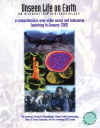Unseen Life on
Earth: An Introduction to Microbiology
The
microbial world leaps off the textbook page and onto the screen with a new
comprehensive microbiology video series and telecourse.
Unseen Life on Earth: An Introduction to Microbiology gives
microbiology educators a unique opportunity to dynamically teach complex topics
and enhance students' understanding of the microbial world.
The telecourse and video
series consists of 12 half-hour programs that cover various aspects of
microbiology. The series is based
on a nationally recommended curriculum, and provides a range of compelling
stories that bring home key microbial principles and concepts and dramatizes
their real-world applications. The
highly versatile program can be adapted to the needs of microbiology, general
biology, allied health, and environmental biology students as well as distance
learners and lifelong learners at home.
The series was produced
with major funding from the National Science
Foundation, the American Society for
Microbiology, the Department of Energy,
and the Annenberg/CPB Project. Additional
funding was provided by the Arthur Vining Davis Foundations and the Corporation
for Public Broadcasting.
Telecourse
Details
Microbial
Cell Biology
1. The Microbial Universe
An overview of the world of microorganisms; how a group of scientists identified
a previously unknown microbe; basic laboratory techniques and microbial genetic
codes.
2. The Unity of Living Systems
Similarities among prokaryotic and eukaryotic organisms; diverse patterns of
cell assembly; the relationship of cell types to non-cell entities such as
viruses.
3. Metabolism
Production of energy and transformation of the environment by microbial
metabolism; construction and use of molecules by microorganisms.
Microbial
Genetics
4. Reading the Code of Life
The central role of DNA in carrying and replicating information; mutations;
microbial regulation of genetic products to conserve energy and adapt to new
environments.
5. Genetic Transfer
Genetic diversity through horizontal gene transfer; conjugation, transformation
and transduction; exploitation of these processes through recombinant DNA.
Integrating
Themes
6. Microbial Evolution
New theories of evolution and the relationships among organisms; development of
genetic techniques using molecular sequences to trace phylogenetic relationships
of microbial life.
7. Microbial Diversity
Relationships between bacteria, archaea, and the eukaryotic branches of life;
impact of diversity in natural habitats and the laboratory.
Microorganisms
in the Environment
8. Microbial Ecology
Microorganisms as processors of oxygen, nutrients and waste; important
environments dominated by microbes; the essential role of microbes in human
life.
9. Microbial Control
Controlling microbes in special situations, e.g., food safety and hospitals;
strategies used in microbial control.
Microorganisms
and Human Life
10. Microbial Interactions
Symbiotic relationships among microbes; relationships between microbes and
higher organisms.
11. Human Defenses
Strategies used by invading microbial pathogens; exploration of the coordinated
human defense system through visual analogy, animation and examples of specific
diseases.
12. Microbes and Human Diseases
Microbial and human encounters that result in disease; factors in disease
outbreaks; current efforts to track infectious diseases and control disease
worldwide.
The series is designed for students who have had introductory biology and
chemistry coursework. The programs in the series are cross-referenced with
current microbiology textbooks:
Microbiology:
An Introduction, Sixth Edition by Tortora, Funke and Case, 1998.
Microbiology,
Fourth Edition by Prescott, Harley, and Klein, 1999.
Introduction to Microbiology, Second Edition by Ingraham and Ingraham,
2000.
The textbook publishers provide student and faculty guides to instructors who
may select guides based on which book they are currently using in the classroom.
Interested educators and institutions can purchase a curriculum package
including the 12 half-hour programs on videotape, a faculty guide and rights to
duplicate one set of videos. For more information, call 1-800-LEARNER or visit Annenberg/CPB
online. Instructors may request a free preview tape. (Interested parties
outside the United States should call 1-847-475-7433 or email pdoyle@mlcworld.com.)
Institutions can also license Unseen Life on Earth: An Introduction to
Microbiology as a complete college-credit telecourse or obtain an off-air
or off-satellite taping license through the PBS Adult Learning Service. Call
1-800-257-2578 or visit the PBS
Adult Learning Service web site. (Note: the telecourse cannot be licensed
for use outside the United States.)
